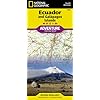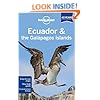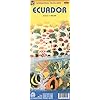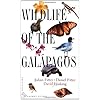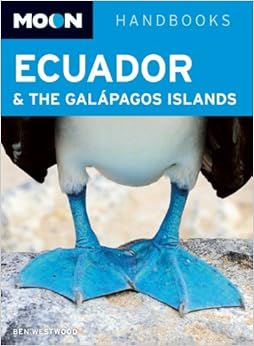
Moon Ecuador & the Galápagos Islands (Moon Handbooks)
and over one million other books are available for Amazon Kindle. Learn more


Flip to back
Flip to front

Moon Ecuador & the Galápagos Islands (Moon Handbooks) Paperback – January 10, 2012

$13.32
FREE Shipping on orders over $35.
Only 8 left in stock (more on the way).
Ships from and sold by Amazon.com.
Gift-wrap available.
NO_CONTENT_IN_FEATURE
Start reading Moon Ecuador & the Galápagos Islands (Moon Handbooks) on your Kindle in under a minute.
Don't have a Kindle? Get your Kindle here, or download a FREE Kindle Reading App.
Don't have a Kindle? Get your Kindle here, or download a FREE Kindle Reading App.
Product Details
Would you like to update product info or give feedback on images?.
|
Editorial Reviews
About the Author
Ben Westwood started dreaming of being a writer and musician at an early age. Growing up in England, he pursued both of his passions by studying music at Westminster University and doing a journalism work placement at national newspaper The Independent. He wrote his first travel journal during a backpacking trip through Southeast Asia.
After graduating from college, Ben decided to follow his passion for travel; with an English-language teaching qualification under his belt, he set off for Ecuador in 1998. In the year he spent there, he fell in love with the country—and one of its citizens. He returned to the UK newly married to study a postgraduate diploma at the country’s top journalism school, City University.
Ben worked for five years for The Daily Telegraph and Telegraph.co.uk as a travel journalist and online travel editor, writing articles on everything from encounters with Maoist guerrillas in Nepal to encounters with drunken Brits in Greece. After a brief stint working in adventure tourism, Ben moved to Ecuador with his wife and children in 2007 to combine his passions for teaching and travel writing. Since then, he has contributed to the The Rough Guide to South America on a Budget and continues to contribute to The Daily Telegraph.
Ben currently teaches journalism, travel writing, English language, and the history of popular music at the Universidad de Especialidades Espíritu Santo, one of Ecuador’s best universities. He still finds time to sing and play the guitar, and has released one self-funded album, Keep Dreaming.
After graduating from college, Ben decided to follow his passion for travel; with an English-language teaching qualification under his belt, he set off for Ecuador in 1998. In the year he spent there, he fell in love with the country—and one of its citizens. He returned to the UK newly married to study a postgraduate diploma at the country’s top journalism school, City University.
Ben worked for five years for The Daily Telegraph and Telegraph.co.uk as a travel journalist and online travel editor, writing articles on everything from encounters with Maoist guerrillas in Nepal to encounters with drunken Brits in Greece. After a brief stint working in adventure tourism, Ben moved to Ecuador with his wife and children in 2007 to combine his passions for teaching and travel writing. Since then, he has contributed to the The Rough Guide to South America on a Budget and continues to contribute to The Daily Telegraph.
Ben currently teaches journalism, travel writing, English language, and the history of popular music at the Universidad de Especialidades Espíritu Santo, one of Ecuador’s best universities. He still finds time to sing and play the guitar, and has released one self-funded album, Keep Dreaming.
Excerpt. © Reprinted by permission. All rights reserved.
Explore Ecuador & the Galápagos Islands with Ben Westwood
1. What is transportation like to the Galápagos and what’s the best way to explore the islands?
There are daily flights to the Galapagos from the Ecuadorian cities of Quito and Guayaquil. Exploring the islands can be done in three ways: on a cruise, on a land-based tour, or independently using daily ferries that shuttle between the three populated islands. You will definitely see more on a cruise because boats travel at night to maximize use of time. There are also many islands that are accessible to cruises, and this is the most environmentally friendly way to see the archipelago. However, for those prone to seasickness, you can see plenty on a land-based tour. While traveling independently requires flexibility, you can save a lot of money by doing it yourself.
2. When is the best time to visit?
Ecuador is a year-round destination, but of course the best times to visit Ecuador are during the many boisterous celebrations on national holidays. The locals know how to party and need little excuse to let their hair down. New Year is famous for the effigies of the Año Viejo (Old Year) that are burnt to culminate festivities, and Carnival is famous for parades and water balloons (expect to get wet!). In the mountains, there are many unique indigenous celebrations include Inty Raymi to mark summer solstice and the raucous Mama Negra (Black Mother) festival in Latacunga. It is a sign of how proud Ecuadorians are of their country that there are no less than four separate days set aside to celebrate various aspects of the country’s independence – The Battle of Pichincha, Simon Bolivar’s birthday, the Independence of Ecuador and independence of Guayaquil, all celebrated with gusto.
3. What are the climates like for the four different geographical regions?
On the coast, the hottest season is between December and May. This also coincides with the rainy season when torrential downpours are quickly followed by strong sunshine. Between June and November it is cloudier, cooler and windier, which suits some people.
On the Galapagos, these seasons are broadly similar but rainfall is lower and tends to be on the higher ground of the larger islands. The sea is far warmer in the hot season, but can get very cold between July and October.
In the mountains, the climate is very different, varying between a comfortable spring-like climate and bone-chillingly wintry. It warms up towards the middle of the year with July and August the warmest, driest months. The wettest period is February to April but light rain falls year-round, usually in the afternoons and evening.
The jungle’s climate varies between wet and wetter: it’s not called the rainforest for nothing! The driest period is around December and the wettest June-July. There are no marked high and low seasons in the mountains and jungle.
4. What do you consider the best place to stay on a budget?
Ecuador is a cheap destination and budget travelers can get by on as little as $20 per day by staying in basic lodging, eating set meals and taking local buses. Prices tend to be higher in the cities of Quito, Cuenca and Guayaquil and on the coast in high season. So the smaller Andean towns and the beach resorts out of season are the best bets for budget travelers.
5. What should travelers never forget to pack?
Pack for all climates: Ecuador is only about the size of Colorado but the variation in terrain is huge. If you want to make the most of it, you need good walking boots and winter clothes for the mountains, binoculars for fabulous bird-watching; for the jungle you need insect repellant and for the coast you need sunglasses and a hat. Wherever you are in Ecuador, the sun is very strong so bring plenty of high-factor sunscreen!
6. Where do you find the best beaches?
Ecuador has beaches to cover all tastes: if you want to party with surfers, head to Montañita; to party with locals, visit Atacames further north. If you want to escape the party-goers, stay in quieter fishing villages such as Mompiche, which has great surfing, or Machalilla National Park on the central coast, which is one of the few protected coastal regions with tropical dry forest leading directly onto pristine beaches. For the best of both worlds, Canoa is developing resort that is quite busy in high season and refreshingly quiet out of season.
7. What’s your favorite Ecuadorian cuisine and where do you find it?
Seafood, seafood and more seafood! I never forget the day I had lobster ceviche, followed by fried sea bass with rice and salad on a beach in Ayangue on the southern coast. The entire meal set me back a grand total of $1.50. The food on Ecuador’s coast is mouthwatering: delicious soups, served cold with lemon and coriander as ceviche, and hot with peanut and plantains as biche. White fish, shrimps, lobster, clams—you name it—can all be served grilled, steamed, breaded or fried with garlic. In particular, don’t miss encocado, a delicious sweet coconut sauce—a specialty of the northern coast.
8. How has volcanic activity shaped Ecuador’s landscape?
Volcanoes dominate two of Ecuador’s regions: the mountains and the Galapagos. The country has no less than 10 peaks over 5,000 meters and a further 12 over 4,000 meters. Towering Chimborazo is actually farther from the center of the Earth than Mount Everest due to the Ecuatorial ridge. The country has 30 active or dormant volcanoes, 10 of which have erupted in the past decade. Most active at present is Tungurahua, which stands just eight kilometers south of the little town of Baños, arguably the region’s most idyllic resort. Luckily, the crater is on the opposite side to town so Baños has escaped unscathed so far.
The Galapagos are volcanic islands and the inhospitable landscapes are what make them so unique. Mammals cannot survive in such parched surroundings so the archipelago developed into an ecological Eden with few natural predators and fearless species. A highlight of a Galapagos visit is still the dramatic hike into the Sulfur mines of Sierra Negra, the second largest crater in the world.
The volcanoes have had such a dominant effect on Ecuador’s history that local folklore has even assigned them personalities. Cotopaxi apparently had an affair with the young passionate female peak Tungurahua, but it wasn’t long before she pursued the taller Chimborazo. Their love-child Guagua Pichincha (Guagua means baby in Kichwa) went north to love with his grandfather Rucu Pichincha. Some locals believe that the eruptions of Guagua and Tungurahua in the past decade were the mother and child calling to each other. Let’s hope the family affairs quieten down soon!
9. Where’s the best place to go for bird watchers?
Ecuador has more than 1,676 types of birds, one-fifth of the total species in the world, which is remarkable for such as small country. The Galapagos are best for close-ups of boobies, frigates, albatrosses, finches, penguins, flamingos and flightless cormorants. Mindo in the cloud forest is incomparable for quetzals and hummingbirds, and the Amazon rainforest is the pick of the regions for sheer numbers: Toucans, parrots, parakeets, vultures, and woodpeckers are just a few of the highlights.
10. What’s the best national park to visit in the Amazon region?
The Amazon region contains Ecuador’s largest mainland national park, Yasuni, which spreads over 9,620 square kilometers of upland tropical forest, seasonally flooded forest, marshes, swamps, lakes and rivers. Untouched by the last Ice Age, this park is one of the world’s most biodiverse areas with 500 species of birds, 130 species of amphibians, 100,000 species of insects and more than 60 per cent of Ecuador’s mammals including jaguars, harpy eagles, pumas, giant otters, tapirs, and monkeys. Unfortunately, some sections of the park are currently at risk from oil exploration and the Ecuadorian government is trying to persuade the world to pay to keep the oil underground. Let’s hope they succeed.
11. What kind of wildlife can travelers expect to see while touring the Galápagos?
On land, the highlight is the giant tortoise. They can live past aged 150, so perhaps we should all take a cue from them and slow down a little. Land iguanas are equally fascinating, and their marine cousins are living proof of evolution, having adapted to dive to the seabed in search of algae, For birdlife, decide which mating ritual is more entertaining: the blue-footed boobies goose-stepping and showing off their bright feet, the frigates inflating their red chests to the size of a basketball or the clacking albatrosses doing their circular dance. For many people the highlight of the islands are the sea lions - walk among their snoozing colonies on the beaches, and snorkel with the playful pups, but watch out for those grouchy males!
More About the Author
Ben Westwood has a BA in music and MA in journalism. A former staff writer at The Daily Telegraph, he has written several travel books including Moon Ecuador, Moon Galapagos and Moon Cusco & Machu Picchu. As well as tourism, he also writes on education and philosophy. Ben is a lecturer in journalism and tourism at University of Brighton.
Customer Reviews
Most Helpful Customer Reviews
30 of 30 people found the following review helpful
By
Mike M.
on May 18, 2012
Format: Paperback
Verified Purchase
Comment
Sending feedback...
This book works for me! I have traveled to Ecuador many times in the past 12 years, as it is an enchanting place I just can't seem to avoid. There is an incredible variety of environments (beach, Andes Mountains, Amazon Jungle, Galapagos Islands) in such a small country. There are also more things to do with more bang for your buck than in most other countries in Latin America.
Previously, I had used Lonely Planet guidebooks exclusively. I decided to give Moon a try after getting tired of Lonely Planet. Ecuador is a fast-changing country and Lonely Planet seemed to rely too much on their previous editions with poor attention to updating info. It is obvious that the author of this book has personally gone to these places and describes them from a first-person point of view. I found this guidebook was spot-on with its descriptions of places I'm already familiar with and extremely helpful for the places I am not.
I am the type to arrive at the bus station, buy a ticket to my next destination and plan my lodging and siteseeing on the way. I never book ahead. On my most recent trip, I visited several locations I had never been to before (Loja, Riobamba, and Puerto Lopez). The descriptions of the places I stayed (restaurants, activities, hotels) were extremely accurate in regards to appearance, quality, amenities and pricing. In addition, the book is very well-written and the stories, descriptions and info boxes make for a very entertaining read on a long Ecuadorian bus ride or short plane hop (that is when you're not glued to the window!).
Believe it or not, I have not yet been to the Galapagos (a bit pricey), but eventually plan on doing so. This is not a place where you'd want to plan your lodgings on the plane ride over there.Read more ›
Previously, I had used Lonely Planet guidebooks exclusively. I decided to give Moon a try after getting tired of Lonely Planet. Ecuador is a fast-changing country and Lonely Planet seemed to rely too much on their previous editions with poor attention to updating info. It is obvious that the author of this book has personally gone to these places and describes them from a first-person point of view. I found this guidebook was spot-on with its descriptions of places I'm already familiar with and extremely helpful for the places I am not.
I am the type to arrive at the bus station, buy a ticket to my next destination and plan my lodging and siteseeing on the way. I never book ahead. On my most recent trip, I visited several locations I had never been to before (Loja, Riobamba, and Puerto Lopez). The descriptions of the places I stayed (restaurants, activities, hotels) were extremely accurate in regards to appearance, quality, amenities and pricing. In addition, the book is very well-written and the stories, descriptions and info boxes make for a very entertaining read on a long Ecuadorian bus ride or short plane hop (that is when you're not glued to the window!).
Believe it or not, I have not yet been to the Galapagos (a bit pricey), but eventually plan on doing so. This is not a place where you'd want to plan your lodgings on the plane ride over there.Read more ›
Thank you for your feedback.
If this review is inappropriate, please let us know.
Sorry, we failed to record your vote. Please try again
6 of 6 people found the following review helpful
By
Nevada City CA
on December 14, 2012
Format: Paperback
Verified Purchase
1 Comment
Sending feedback...
We took this book on our recent trip to Ecuador where we visited Quito, the Oriente (amazon rain forest) and the Galapagos. We found it to be a great guidebook. I particularly enjoyed the long background sections describing Ecuador's geography, history and people. I think it is so important to gain an understanding of the countries you visit, not just check off a list of tourist sites.
Thank you for your feedback.
If this review is inappropriate, please let us know.
Sorry, we failed to record your vote. Please try again
3 of 3 people found the following review helpful
By
Christopher Pimental
on August 2, 2012
Format: Paperback
Comment
Sending feedback...
I'm familiar with Ecuador, and upon going through this book it became immediately clear that Mr. Westwood put considerable effort and travel into his research. He provides a legitimate "been there" perspective and a modern, up-to-date log of the country. Sharp writing, accurate details, and bite-sized nuggets of interest add insight to perfect settings and relevant information. This is a well organized and credible guide book, worth the few bucks you'll pay and most importantly, a smart travel companion.
Thank you for your feedback.
If this review is inappropriate, please let us know.
Sorry, we failed to record your vote. Please try again
4 of 5 people found the following review helpful
By
Emma L
on March 30, 2012
Format: Paperback
Verified Purchase
1 Comment
Sending feedback...
Before I purchased this book, I did some research online to plan the big parts of the trip- which cities to visit, how long to stay in each place, etc. I found that most travel books include their "recommended itineraries" in the free sample, so you can easily compare and find the popular destinations. Frommers even has a great map with their top destinations marked on the map.
I wanted a guidebook to figure out hotels, food, and travel logistics, and to suggest "filler activities" - once we're in Quito, what should we do that we wouldn't have otherwise thought of?
I'm still planning for my trip, so I can't speak to the accuracy of this book yet.
First impressions:
The sections on food and hotels look great- food divided into types of food (French, Italian, Mexican, etc.) and then cost (rather than just cost, like Lonely Planet does) and marking favorites with their moon so you can easily find/ go to their favorites. It has good sections on "getting there and getting away" that chart travel cost/time. It seems like it will be helpful in planning my budget and logistics. The sections on things to see in each city look helpful- and each "zone" includes a list of 5-6 things that are the recommended highlights for that zone, which is nice.
BUT- the maps are horrible. I have relied on Lonely Planet maps to get around a few different countries, and I've gotten used to the grid system, where they tell you "hotel A" or "restaurant B" is found in C4, so you can easily find it. The Moon maps have nothing like that. You have to search through the entire map to find the hotel you've picked out. I found this incredibly frustrating.
The worst, however, is trying to find important things like the bus station in Quito.Read more ›
I wanted a guidebook to figure out hotels, food, and travel logistics, and to suggest "filler activities" - once we're in Quito, what should we do that we wouldn't have otherwise thought of?
I'm still planning for my trip, so I can't speak to the accuracy of this book yet.
First impressions:
The sections on food and hotels look great- food divided into types of food (French, Italian, Mexican, etc.) and then cost (rather than just cost, like Lonely Planet does) and marking favorites with their moon so you can easily find/ go to their favorites. It has good sections on "getting there and getting away" that chart travel cost/time. It seems like it will be helpful in planning my budget and logistics. The sections on things to see in each city look helpful- and each "zone" includes a list of 5-6 things that are the recommended highlights for that zone, which is nice.
BUT- the maps are horrible. I have relied on Lonely Planet maps to get around a few different countries, and I've gotten used to the grid system, where they tell you "hotel A" or "restaurant B" is found in C4, so you can easily find it. The Moon maps have nothing like that. You have to search through the entire map to find the hotel you've picked out. I found this incredibly frustrating.
The worst, however, is trying to find important things like the bus station in Quito.Read more ›
Thank you for your feedback.
If this review is inappropriate, please let us know.
Sorry, we failed to record your vote. Please try again
2 of 2 people found the following review helpful
By
clf
on March 3, 2013
Format: Paperback
Verified Purchase
1 Comment
Sending feedback...
Thorough and well written. Like layout of book, maps, photos, all of it. Highly recommend for those planning trip to Ecuador or Galapagos.
Thank you for your feedback.
If this review is inappropriate, please let us know.
Sorry, we failed to record your vote. Please try again
1 of 1 people found the following review helpful
By
NickyK
on November 13, 2012
Format: Paperback
Verified Purchase
Comment
Sending feedback...
This book was very helpful but since I didn't spend much time in Ecuador, the South American travel guide would have sufficed. If you plan to spend more than 2 weeks in Ecuador, this book will be great.
Thank you for your feedback.
If this review is inappropriate, please let us know.
Sorry, we failed to record your vote. Please try again
1 of 1 people found the following review helpful
By
Amazon Customer
on May 18, 2012
Format: Paperback
Comment
Sending feedback...
This is a good guide with very valuable information. I have been to Ecuador several times and the recommendations in the book are very solid. I recommend this guide for any Ecuador traveler.
Thank you for your feedback.
If this review is inappropriate, please let us know.
Sorry, we failed to record your vote. Please try again
By
Walid Zairi
on September 5, 2014
Format: Paperback
Verified Purchase
Comment
Sending feedback...
Very good guide. I used it for my first trip to Ecuador this past August 2014. The guide is very accurate, there are very good ideas of things to do. Prices of hotels went up by about 5-10 dollars since the instauration of new taxes in Ecuador.
I wish this book had color photos/illustrations. I also think that Ecuador is so much more than just the Galapagos. Most Ecuadorians (99%) have never been there because it's so expensive to get there. Ecuador has so much to offer than just the Galapagos. It should not be on the cover and should not be on this guide in my opinion as it can be easily placed on a separate guidebook.
I wish this book had color photos/illustrations. I also think that Ecuador is so much more than just the Galapagos. Most Ecuadorians (99%) have never been there because it's so expensive to get there. Ecuador has so much to offer than just the Galapagos. It should not be on the cover and should not be on this guide in my opinion as it can be easily placed on a separate guidebook.
Thank you for your feedback.
If this review is inappropriate, please let us know.
Sorry, we failed to record your vote. Please try again
